Grumman OV-1 Mohawk
The Grumman OV-1 Mohawk was an armed military observation and attack aircraft, designed for battlefield surveillance and light strike capabilities. It was a twin turboprop configuration, and carried two crew members in side-by-side seating. The Mohawk was intended to operate from short, unimproved runways in support of United States Army maneuver forces.
| OV-1 Mohawk | |
|---|---|
.jpg) | |
| US Army OV-1D Mohawk | |
| Role | light attack and observation aircraft |
| Manufacturer | Grumman |
| First flight | 14 April 1959 |
| Introduction | October 1959 |
| Retired | September 1996 (USA) |
| Status | Retired |
| Primary users | United States Army (historical) Argentine Army Aviation (historical) |
| Produced | 1959–1970 |
| Number built | 380 |
Development
The Mohawk began as a joint Army-Marine program through the then-Navy Bureau of Aeronautics (BuAer), for an observation/attack plane that would outperform the Cessna L-19 Bird Dog. In June 1956, the Army issued Type Specification TS145, which called for the development and procurement of a two-seat, twin turboprop aircraft designed to operate from small, unimproved fields under all weather conditions. It would be faster, with greater firepower, and heavier armour than the Bird Dog, which had proved vulnerable during the Korean War. The Mohawk's mission would include observation, artillery spotting, air control, emergency resupply, naval target spotting, liaison, and radiological monitoring. The Navy specified that the aircraft must be capable of operating from small "jeep" escort class carriers (CVEs). The DoD selected Grumman Aircraft Corporation's G-134 design as the winner of the competition in 1957. Marine requirements contributed an unusual feature to the design. As originally proposed, the OF-1 could be fitted with water skis that would allow the aircraft to land at sea and taxi to island beaches at 20 knots. Since the Marines were authorized to operate fixed-wing aircraft in the close air support (CAS) role, the mockup also featured underwing pylons for rockets, bombs, and other stores.
The Air Force did not like the armament capability of the Mohawk and tried to get it removed. The Marines did not want the sophisticated sensors the Army wanted, so when their Navy sponsors opted to buy a fleet oil tanker, they dropped from the program. The Army continued with armed Mohawks and developed cargo pods that could be dropped from underwing hard points to resupply troops in emergencies.
The radar imaging capability of the Mohawk was to prove a significant advance in both peace and war. The Side-Looking Airborne Radar (SLAR) could look through foliage and map terrain, presenting the observer with a film image of the earth below only minutes after the area was scanned. In military operations, the image was split in two parts, one showing fixed terrain features, the other spotting moving targets.
The prototype (YAO-1AF) first flew on April 14, 1959. The OV-1 entered production in October 1959.
In mid-1961, the first Mohawks to serve with U.S. forces overseas were delivered to the 7th Army at Sandhofen Airfield near Mannheim, Germany. Before its formal acceptance, the camera-carrying AO-1AF was flown by Ralph Donnell on a tour of 29 European airfields to display it to the U.S. Army field commanders and potential European customers. In addition to their Vietnam and European service, SLAR-equipped Mohawks began operational missions in 1963 patrolling the Korean Demilitarized Zone. Germany and France showed early interest in the Mohawk, and Grumman actually signed a license production agreement with the French manufacturer Breguet Aviation in exchange for American rights to the Atlantic maritime patrol aircraft.
The very nature of the joint Army/Marine program had forced design compromises, such as ejection seats,[1] that made the aircraft expensive and, sometimes, an openly resisted item in Army budgets. Orders for the OV-1 stopped in Fiscal 1964, and the controversy in the Pentagon over the armed Mohawk peaked with a 1965 directive that prohibited the Army from operating armed fixed-wing aircraft (See the Johnson-McConnell agreement of 1966). Operational success in Vietnam led to additional Mohawk orders in 1966, and by 1968, five surveillance companies were operating in Southeast Asia.
The last of the Mohawk versions to enter production was the OV-1D with more powerful T53-701 engines, improved avionics, and interchangeable mission pallets that made it possible to switch the aircraft from infrared to SLAR configuration in about an hour. The first four OV-1Ds were prototypes converted from earlier production airframes, and the first flew in 1969. These were followed by 37 new-build aircraft, the last of which was delivered in December 1970.
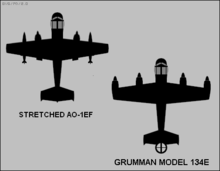
Over the years, the mission and the aircraft underwent many changes and roughly 380 were built over all variants. Mohawk variants included the JOV-1 [armed reconnaissance], OV-1A, [visual and photographic], OV-1B [visual, photographic, and side-looking radar (SLAR) pod], the OV-1C [visual, photographic, and infrared], and the OV-1D (SLAR pod and bigger wings), OV-1E [enlarged fuselage for more sensor operators or cargo], EV-1E [special electronic intelligence installation] and RV-1E [advanced ELINT reconnaissance]. A four-engined Model 134E with tiltwings and tail ducted fan for control for VTOL was proposed to the Army but not built. Model 134R was a tandem cockpit version offered to meet the Light Armed Reconnaissance Aircraft (LARA) requirement, but the NA300 was chosen instead becoming the OV-10.
Operational history
United States Army
The U.S. Army flew the OV-1 operationally in the Vietnam War, with sixty-five lost to accidents, ground fire, and one shot down by a North Vietnamese fighter.[2] The Army also used the aircraft during Operation Desert Storm.
Starting in 1972, the Army National Guard (ARNG) began to receive the Mohawk, with the ARNG eventually operating thirteen OV-1Bs, twenty-four OV-1Cs, and sixteen OV-1Ds serving with three aviation units in Georgia and Oregon. The Oregon Army National Guard Unit operating the Mohawk was located at McNary Field in Oregon, initially as the 1042nd Military Intelligence Company (Aerial Surveillance), then reflagged as the 641st Military Intelligence Battalion (CEWI)(Aerial Exploitation).
U.S. Army OV-1s were retired from Europe in 1992, from Korea in September 1996, and finally in the United States in 1996, superseded by newer systems, newer aircraft, and the evolution of reconnaissance satellites. The OV-1 was primarily replaced by the EO-5C, a militarized version of the de Havilland Canada Dash 7 turboprop airliner equipped with a SLAR system, until the U.S. Air Force's Northrop Grumman E-8 Joint STARS (Joint Surveillance Target Attack Radar System) aircraft became fully operational.
As of 2011, Alliant Techsystems partnered with the Broadbay Group and Mohawk Technologies of Florida in a venture to return an armed, modernized version of the OV-1D to operational use as a counter-insurgency aircraft. A demonstrator was equipped with a FLIR Star Safire turret and a ventral, trainable M230 chain gun.[3][4]
Argentine Army
The Argentine Army Aviation received twenty-three OV-1 in the 1990s. Ten were operational and the rest were used for spare parts.[5] They became inactive and retired from use in 2015.
Accidents and incidents
In early 1968, while flying an OV-1 over South Vietnam, U.S. Army Captain Ken Lee shot down a MiG-17 “Fresco” fighter jet with his XM14 .50 caliber gun pods as well as two M159 unguided rocket pods, becoming the only Army Aviator to ever down a MiG. Due to the Key West Agreement, the Army tried to keep the shootdown a secret for fear that it would allow the USAF to transfer Mohawks to its inventory. Lee's kill was finally formally recognized by the Army in 2007. [6]
On November 1, 2019 at 13:15, a Grumman OV-1D Mohawk operated by Mohawk Airshows crashed at Witham Field, Stuart, Florida, during the Stuart Air Show. The aircraft was destroyed and the pilot was killed. Its serial number was 68-15958.
Variants
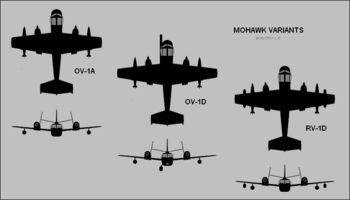
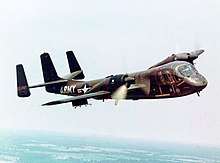
%2C_USA_-_Army_AN1188459.jpg)
- YAO-1 (YOV-1A)
- Initial prototypes (9 built).
- OV-1A (AO-1AF)
- Daylight observation variant (64 built).
- OV-1B (AO-1BF)
- SLAR variant (101 built).
- OV-1C (AO-1CF)
- IR reconnaissance variant (169 built).
- OV-1D
- Consolidated sensor variant (37 new, 82 conversions).
- JOV-1A
- OV-1As and OV-1Cs fitted with armament (59 conversions).
- RV-1C
- Quick Look ELINT machines (two conversions).
- RV-1D
- Quick Look II ELINT machine (31 conversions).
- EV-1E
- Quick Look III ELINT machine (16 conversions).
- OV-1E
- Prototype for unproduced modernized variant (1 built).
Former operators
Surviving aircraft
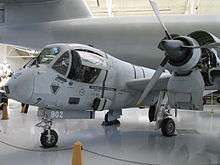
.jpg)
Airworthy
- 59-2604 – OV-1A flown by the Planes of Fame Air Museum in Chino, California.[8]
- 59-2631 – United States Military Air Power Museum in Jacksonville, FL has the only restored and flying OV-1B [9]
- 62-5874 – Flown by the Carolinas Aviation Museum at airshows.[10]
- 62-5889 – Cavanaugh Flight Museum flies one Mohawk[11][12]
- 62-5890 – Flown by the Carolinas Aviation Museum at airshows.[13]
- 64-14262 – American Wings Air Museum, Blaine, Minnesota.[14]
- 67-15959 – Operated by Mohawk Technologies and based at Palm Beach County Park Airport in Lantana, Florida.[15]
- 67-18899 – Operated by Mohawk Technologies and based at Palm Beach County Park Airport in Lantana, Florida.[16]
- 67-18923 – Operated by Mohawk Technologies and based at Palm Beach County Park Airport in Lantana, Florida.[17]
- 67-18924 – Operated by Mohawk Technologies and based at Palm Beach County Park Airport in Lantana, Florida.[18]
- 67-18926 – Owned by Paul Pefley, CEO of Mohawk Technologies, and based at Palm Beach County Park Airport in Lantana, Florida.[19][20]
- 68-15936 – American Wings Air Museum, Blaine, Minnesota.[21]
- 68-15946 – Operated by Mohawk Technologies and based at Palm Beach County Park Airport in Lantana, Florida.[22]
- 68-15947 – Located at Air Heritage Museum, Beaver County Airport, Pennsylvania. No longer owned by museum.[23]
- 69-17004 – Operated by Mohawk Technologies and based at Palm Beach County Park Airport in Lantana, Florida.[24]
- 69-17021 – American Wings Air Museum, Blaine, Minnesota.
Static display
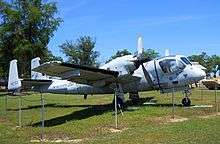
- 57-6539 – YOV-1A on display at the United States Army Aviation Museum in Fort Rucker, Alabama.
- 59-2633 – OV-1B on display at Cradle of Aviation Museum
- 60-3747 – OV-1C on display at the 1st Cavalry Division Museum in Fort Hood, Texas.[25]
- 61-2724 – The Pima Air & Space Museum adjacent to Davis–Monthan Air Force Base in Tucson, Arizona lists an OV-1C Mohawk as a static display[26]
- 62-5856 – The Wings of Eagles Discovery Center owns an OV-1C on static display among its collection[27]
- 62-5860 – OV-1B on display at the United States Army Aviation Museum at Fort Rucker, Alabama.[28][29]
- 62-5875 – Headquarters, 48th Infantry Brigade Combat Team, (Georgia Army National Guard) in Macon, Georgia displays a static OV-1D as part of an outdoor exhibit[30]
- 62-5880 – Texas Air Museum in Slaton, Texas has a modified OV-1D that was used by NASA that is on loan from the Museum of Naval Aviation.[31]
- 62-5906 – Cockpit only on display at the Valiant Air Command Warbird Museum.[32]
- 63-13128 - Military Aviation Preservation Society (MAPS) Air Museum (under restoration for museum display)[33]
- 64-14247 – The United States Army's Tobyhanna Army Depot in Tobyhanna, Pennsylvania, has an OV-1B on display outside the main gate access control point.
- 64-14252 – The Mississippi Armed Forces Museum at Camp Shelby has an OV-1 on static display[30]
- 67-15959 – The G-Star School of the Arts in West Palm Beach, Florida displays a static OV-1D[34][35]
- 67-18902 – The Evergreen Aviation & Space Museum in McMinnville, Oregon displays a static OV-1D[36]
- 67-18922 – Hunter Army Airfield in Savannah, Georgia displays a static OV-1D as part of an outdoor exhibit[30][37]
- 67-18930 – Fort Huachuca, Arizona maintains a static display of an OV-1 Mohawk[38]
- 68-15932 – OV-1D c/n 136C, Argentine Army Aviation AE-021 – displayed at the Argentine Army Museum ((in Spanish) Museo Histórico del Ejército), Buenos Aires, Argentina.[39]
- 68-15939 – McClain's Military Museum in Anderson, Indiana has an OV-1 on static display
- 69-16998 – The Valiant Air Command Warbird Museum at Space Coast Regional Airport in Titusville, Florida has a static OV-1 on display[40]
- 69-17007 – The 1st Cavalry Division Museum at Fort Hood, Texas displays a static OV-1D as part of an outdoor exhibit[30][41]
- 69-17010? – The United States Army Aviation Museum at Fort Rucker, Alabama displays a static OV-1D as part of the outdoor exhibit at the intersection of Red Cloud Avenue and Ruf Avenue
- 69-17022 - United States Army Garrison Humphreys, Republic of Korea, OV-1 Mohawk displayed outdoors at the intersection round-a-bout of Key Street & CPX Road
- The United States Army Intelligence and Security Command Headquarters Building at Fort Belvoir, Virginia displays a static OV-1D[30]
- AZO Plane Partners in current possession of the Air Zoo's OV-1D
- OV-1D ex-Argentine Army Aviation, in the Aviación del Ejército Argentino Park Buenos Aires, Argentina
Specifications (OV-1D)
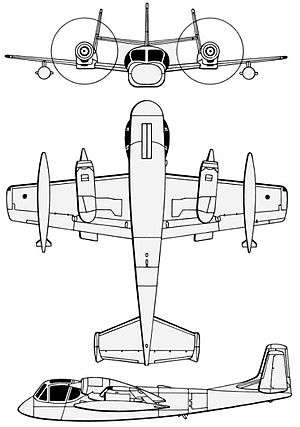
Data from Jane's Civil and Military Aircraft Upgrades 1994–95[42]
General characteristics
- Crew: 2
- Length: 41 ft 0 in (12.50 m)
- Wingspan: 48 ft 0 in (14.63 m)
- Height: 12 ft 8 in (3.86 m)
- Wing area: 360 sq ft (33 m2)
- Aspect ratio: 5.35:1
- Airfoil: NACA 2412
- Empty weight: 12,054 lb (5,468 kg)
- Gross weight: 15,544 lb (7,051 kg) (Normal take-off weight, IR mission)
- Max takeoff weight: 18,109 lb (8,214 kg) (SLAR mission)
- Fuel capacity: 276 US gal (230 imp gal; 1,040 L) internal fuel
- Powerplant: 2 × Lycoming T53-L-701 turboprops, 1,400 shp (1,000 kW) each
- Propellers: 3-bladed Hamilton Standard Type 53C51-27 constant-speed propellers, 10 ft 0 in (3.05 m) diameter
Performance
- Maximum speed: 305 mph (491 km/h, 265 kn) (IR mission)
- Cruise speed: 207 mph (333 km/h, 180 kn) (econ. cruise)
- Stall speed: 84 mph (135 km/h, 73 kn)
- Never exceed speed: 450 mph (720 km/h, 390 kn)
- Range: 944 mi (1,519 km, 820 nmi) with external tanks (SLAR mission)
- Endurance: 4.35 hr (SLAR mission)
- Service ceiling: 25,000 ft (7,600 m)
- Rate of climb: 3,466 ft/min (17.61 m/s) (SLAR mission)
- Take-off to 50 ft (15 m): 1,175 ft (358 m)
- Landing run from 50 ft (15 m): 1,060 ft (320 m)
See also
Aircraft of comparable role, configuration and era
References
- Notes
- "The Ejection Site: OV-1 Mohawk Ejection Seats".
- "The OV-1 Mohawk Remembered Firsthand: Piloting the Mohawk in Vietnam". Defense Media Network. 24 September 2013. Retrieved 15 December 2015.
- Defense Technology International Magazine. Washington, D.C.: McGraw-Hill/DTI. 5 (4)): 40. April 2011. ISSN 1935-6269. Missing or empty
|title=(help) - Reed, John (2010-10-28). "Old School COIN Planes Keep Coming Back". Defensetech.
- "Mohawk Airshows: OV-1 Factsheet". Dover Air Force Base. Retrieved 10 March 2020.
- https://warisboring.com/the-armys-only-air-to-air-kill-since-wwii-was-done-with-a-50-cal-in-vietnam/
- "Grumman OV-1 Mohawk (Hebrew nickname: 'Atalef' ('Bat'))". Israeli Air Force. Retrieved 10 March 2020.
- "Grumman OV-1A". Planes of Fame Air Museum. Retrieved December 31, 2015.
- "OV-1B Mohawk – High Performance Reconnaissance / Attack Airplane". Joshua G. Newsteder. Retrieved 2016-01-25.
- "FAA REGISTRY". Federal Aviation Administration. U.S. Department of Transportation. Retrieved 26 February 2016.
- "Articles". Cavanaugh Flight Museum. Retrieved 5 January 2016.
- "Airframe Dossier – GrummanOV-1 Mohawk, s/n 62-5889 US Army, c/r N134GM". Aerial Visuals. AerialVisuals.ca. Retrieved 5 January 2016.
- "FAA REGISTRY". Federal Aviation Administration. U.S. Department of Transportation. Retrieved 26 February 2016.
- "FAA REGISTRY". Federal Aviation Administration. U.S. Department of Transportation. Retrieved 26 February 2016.
- "FAA REGISTRY". Federal Aviation Administration. U.S. Department of Transportation. Retrieved 26 February 2016.
- "FAA REGISTRY". Federal Aviation Administration. U.S. Department of Transportation. Retrieved 25 February 2016.
- "FAA REGISTRY". Federal Aviation Administration. U.S. Department of Transportation. Retrieved 26 February 2016.
- "FAA REGISTRY". Federal Aviation Administration. U.S. Department of Transportation. Retrieved 26 February 2016.
- "FAA REGISTRY". Federal Aviation Administration. U.S. Department of Transportation. Retrieved 26 February 2016.
- "Mohawk Technologies LLC". Manta. Manta Media Inc. Retrieved 26 February 2016.
- "FAA REGISTRY". Federal Aviation Administration. Federal Aviation Administration. Retrieved 26 February 2016.
- "FAA REGISTRY". Federal Aviation Administration. U.S. Department of Transportation. Retrieved 26 February 2016.
- "Airframe Dossier – Grumman OV-1 Mohawk, s/n 68-15947 US, c/r N947AH". Aerial Visuals. AerialVisuals.ca. Retrieved 6 January 2016.
- "FAA REGISTRY". Federal Aviation Administration. U.S. Department of Transportation. Retrieved 25 February 2016.
- "Airframe Dossier – Grumman OV-1C Mohawk, s/n 60-3747 US, c/n 3C". Aerial Visuals. AerialVisuals.ca. Retrieved 6 January 2016.
- "MOHAWK". Pima Air & Space Museum. PimaAir.org. Retrieved 6 January 2016.
- "Aircraft". Wings of Eagles Discovery Center. Archived from the original on 2011-09-07. Retrieved 2011-09-07.
- "Fixed Wing". United States Army Aviation Museum. Army Aviation Museum Foundation, Inc. Archived from the original on 22 December 2016. Retrieved 6 January 2016.
- "Airframe Dossier – Grumman OV-1B Mohawk, s/n 62-5860 US, c/n 19B". Aerial Visuals. AerialVisuals.ca. Retrieved 6 January 2016.
- Where Are They Now? MohawkStatus Archived 2016-03-04 at the Wayback Machine retrieved 2015-06-05
- "Grumman OV-1 Mohawk". Texas Air Museum. The Texas Air Museum. Retrieved 6 January 2016.
- "Airframe Dossier – Grumman OV-1 Mohawk, s/n 62-5906 US Army". Aerial Visuals. AerialVisuals.ca. Retrieved 6 January 2016.
- Ongoing Aircraft Renovation Projects, MAPS Air Museum, last accessed 16 November 2018
- "FAA Registry - Aircraft - N-Number Inquiry". registry.faa.gov. Retrieved 22 June 2018.
- "G-Star Warplane on Cover of Smithsonian Magazine & in PB Post! | G-Star School of the Arts | Palm Beach County Charter High Schools". G-Star School of the Arts | Palm Beach County Charter High Schools. 2017-08-20. Retrieved 22 June 2018.
- Evergreen Aviation & Space Museum military aircraft collection retrieved 2013-06-02
- "Wrecks and relics online – Aircraft wreck or relic at Savannah, Georgia, United States". Spotting Mode. iksmode. Retrieved 6 January 2016.
- Fort Huachaca Museum website retrieved 2013-06-02
- "Ejército – Flota – Grumman OV-1D Mohawk" (in Spanish). Aeromilitaria. 2007-10-21. Archived from the original on 15 October 2003. Retrieved 27 March 2016.
- Mohawk at the Valiant Air Command Warbird Museum Archived 2012-01-28 at the Wayback Machine retrieved 2013-06-02
- "Gate Guards and Base Displays (not museums)". Fence Check. Liza Eckardt. Retrieved 6 January 2016.
- Michell 1994, pp. 366–367.
- Bibliography
- Michell, Simon (1994). Jane's Civil and Military Aircraft Upgrades 1994–95. Coulsdon, UK: Jane's Information Group. ISBN 0-7106-1208-7.
- Neubeck, Ken (2007). OV-1 Mohawk – Walk Around No. 49. Carrollton, Texas: Squadron/Signal Publications, Inc. ISBN 978-0-89747-540-2.
The initial version of this article was based on a public domain article from Greg Goebel's Vectorsite.
Further reading
- Printed sources
- Gebel, Guillermo; Mosquera, Javier; Clariá, Horacio; Cettolo, Vladimiro; Marino, Atilio; Posadas, Guillermo (2007). Grumman OV-1D Mohawk en la Aviación de Ejército [Grumman OV-1D Mohawk in the Army Aviation] (in Spanish). Buenos Aires, Argentina: Avialatina. ISBN 978-987-24081-0-7. Retrieved 15 August 2015.
- Online sources
- Javier Mosquera & Guillermo Gebel (31 December 2002). "10 años del OV-1D Mohawk en el Ejército Argentino". Gaceta Aeronautica (in Spanish). Gaceta Aeronautica. Retrieved 2015-08-15.
- "Ejército > Flota > Grumman OV-1D Mohawk". Aeromilitaria (in Spanish). Carlos Ay. 21 October 2007. Retrieved 2015-08-15.
- "20 Años de OV-1D Mohawk en la Aviación de Ejército". Avialatina – Noticias (in Spanish). Avialatina. 14 December 2012. Retrieved 2015-08-15.
- "El Ejército Argentino modernizará su flota aérea con la compra de nueve aviones". Infodefensa (in Spanish). IDS, Información de Defensa y Seguridad. 17 December 2013. Retrieved 2015-08-15.
External links
| Wikimedia Commons has media related to Grumman OV-1 Mohawk. |
- OV-1 US Army Aviation history fact sheet
- The Grumman OV-1 Mohawk at Greg Goebel's AIR VECTORS
- The short film Big Picture: Flying Soldiers is available for free download at the Internet Archive
- Mohawk as monument in the Aviación del Ejército Argentino Park